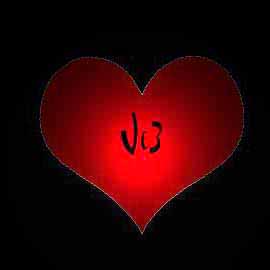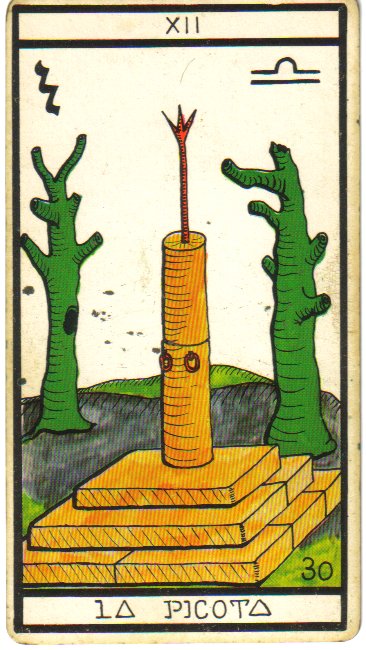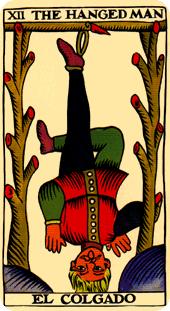 heart shaped world
heart shaped world
| fool | the magician |
high priestess | empress | emperor | hierophant | lovers | chariot | justice | hermit | wheel of fortune |
| strength | the hanged man | death | temperance | the devil | the tower | the star | the moon | the sun | judgement | the world |

Picota, in Spanish, is a hilltop, a peak but historically La Picota is also the name for the pillory depicted in my Spanish deck, from Vitoria in Euskadi (Pais Vasco)*. The pillory was essentially a whipping post serving also as a place of public humiliation for petty criminals who were adjudged to deserve more than the stocks. Together with its shamanic cousin (the flying pole) it gives the sense of being altogether in a very strange place, an altered state, with overtones of humility and self-sacrifice but all towards redemption or revelation, or both. In the picture above note the symbolic use of the two trees either side of the 'picota' which recall the pillars guarded by the High Priestess. These are also visible as the supporting posts in the Marseilles image. You will notice many links that group certain cards together when you study your deck closely. Consider related themes and areas of meaning. Notice too that the illustrated card shows an affinity with astrological Libra and the card also bears a kabbalah marking and the numerals 30 - such additions have localised meaning and frames of reference with the society/order associated with the publication of the deck.
* the Basque Country
 The Romans, probably addressing boredom, were given to
occasionally crucifying people upside down.
Several martyrs were dispatched in this way. Some decks show the Hanged
Man in such a crucifixion attitude. It
is not the image that we should be using.
The Romans, probably addressing boredom, were given to
occasionally crucifying people upside down.
Several martyrs were dispatched in this way. Some decks show the Hanged
Man in such a crucifixion attitude. It
is not the image that we should be using.
The Hanged Man refers to a shamanic tradition of creating a
mind-altering state through increasing the blood flow to the brain. Some used ‘flying poles’ – attaching one
ankle to a sleeve that was set loosely round a pole they would run, then throw
themselves horizontal and ‘fly’ as the sleeve revolved around the pole. It recalls children spinning around in ordr to make themselve's dizzy. I imagine that landing nose first in the mud
caused the widespread shift to teas brewed with hallucinogens (cacti,
mushrooms, lichens) which created a more powerful and less immediately painful
effect.
However it is achieved, the
Hanged Man represents altered consciousness, even expanded consciousness,
certainly a new perspective. It’s a
different angle on life, on your issues and problems. One that has been
achieved, one that would be beneficial.
Or someone acting from such a viewpoint.
Context is everything. The Hanged
Man can confer the ability to rise above limitations or defy the odds through
innovative, creative or lateral thinking.
